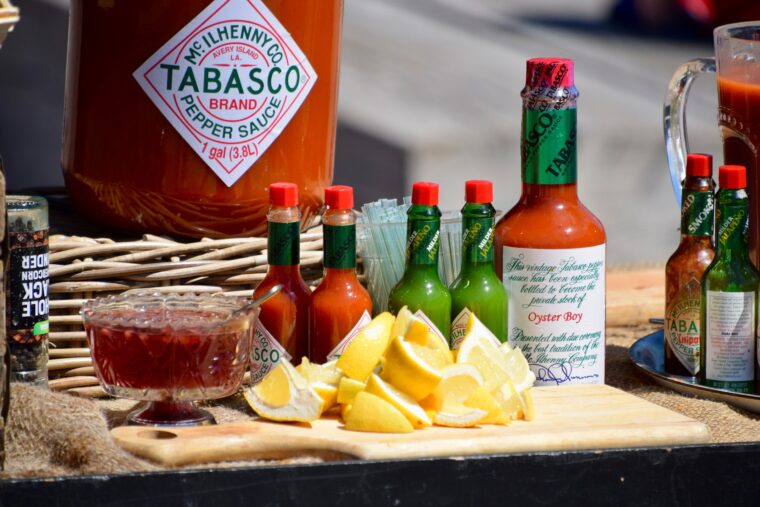Condiment Craze
If you were to open any Irish person’s fridge, chances are you’d find a collection of stalwart condiments cluttering the fridge door: mayonnaise, ketchup, maybe some marmalade or raspberry jam. However in recent years, a new breed has emerged, raising the bar for what a condiment can do. Our choice of condiments has expanded as Irish food grows to include more global flavours. Spicy, umami, crunchy, zingy—these condiments broaden our tastes and elevate the humblest toast or fried egg with a smear or a spoonful. According to data from Statista, the market for sauces and condiments is showing steady growth worldwide, while the market for spreads is also expected to grow annually by 3.10% (CAGR 2021-2025). The big players in classic condiments are diversifying their ranges. Meanwhile, the shelves of local speciality food stores are now stuffed with the creative condiments of small Irish producers.

Mayonnaise is having a moment. Since Heinz first took on Hellman’s by launching its Seriously Good Mayonnaise in 2018, Heinz has continued to innovate products such as truffle mayonnaise and ‘Saucy Sauce’, a ketchup and mayonnaise hybrid. For St. Patrick’s Day this year, Heinz released a limited run of green mayonnaise made with shamrocks grown in Kerry. Ballymaloe, arguably Ireland’s most famous condiment brand, has also branched into mayonnaise. Last year, this Irish-made mayo was given a Great Taste award. Kewpie, a long beloved household staple in Japan, has been steadily converting chefs and foodies all over the world. David Chang, the founder of Momofuku and the host of Netflix show Ugly Delicious has called it the ‘best mayonnaise in the world’ thanks to its inclusion of MSG. You may have noticed Kewpie’s cartoon logo and iconic super-squeezy bottle in both Ireland’s Asian markets, and some of its trendiest food and lifestyle stores.
Hot sauce remains an area of growth. The global hot sauce market is expected to reach a value of US$ 5.9 Billion by 2025. Ever since Sriracha first took the world by storm, our collective appetite for spice has only gotten bigger. Small-batch, Irish hot sauce brands such as Savage Sauces and Rebel Chili have seen great success. Ballymaloe also launched Fiery Relish last year. Irish awareness of spice is now well beyond sweet chili sauce. People are increasingly seeking new chili-based condiments from Africa, Asia, and South America. Trends Forecaster WGSN reports that chili condiments such as Japanese yuzu kosho, Indonesian Sambal, and Yemeni zhoung will grow in global popularity. Chili Crisp style condiments have become especially popular in recent years. Chef Kwanghi Chan, who was born in Hong Kong and raised in Donegal, has a range of Asian inspired condiments from his brand Chan Chan, such as Black Garlic and Peanut Rayu. White Mausu, by Chef Katie Sanderson, now has three products: Peanut Rayu, Cashew Crunch and Black Bean Rayu. Over the course of the pandemic the brand has grown its list of stockists from 200 to 450, as well as gaining recognition abroad.
The tagline on White Masu’s website, ‘Drizzle. Dollop. Dip. Repeat,’ perfectly sums up the appeal of such condiments. They are adaptable meal-makers. Galway-based brand, The Sea Hare’s Tamarind sauce boosts similar versatility. Harry’s Nutbutter, a spicy-savoury peanut butter, suggests everything from West African style soup to a toastie in its applications. The interest in fermented condiments, such as Jaru’s Kimchi or The Cultured Food Company’s sauerkraut is also unwavering. With more people cooking at home over lockdown, many are grateful for short-cuts to bold flavour. These condiments can help us keep things exciting when we are running out of ideas. For those fully relishing the experience of home cooking, condiments can serve as a gateway for exploration, especially of some of the international cuisines many may be missing from travel. Condiments have also served as an accessible entry point for budding food businesses and chefs and restaurants looking to diversify their income streams over the pandemic. With lockdown providing many people in the food world with the time and impetus to take on new projects, many more Irish condiment launches are likely still eminent. The competition is heating up, however. The window to be the first of a particular condiment, like rayu or kimchi, to reach the Irish market is closing. Brands will have to push their creativity further to ensure their product stands out from the crowd. And consumers will need to make sure there is plenty of room in their fridge. There’s going to be a lot to taste.




